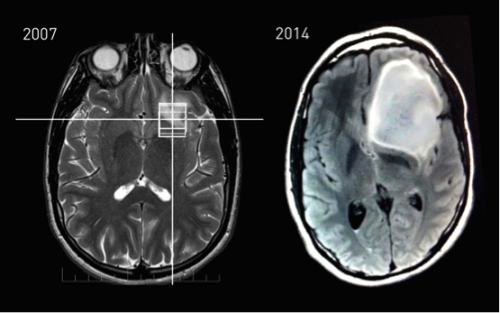D. S. Fahmeed Hyder, Professor of Biomedical Engineering & of Radiology and Biomedical Imaging at Yale, specializes in tumor imaging, neuroscience, and neuro-oncology using Magnetic Resonance Imaging (MRI) and Spectroscopy (MRS) methods at Yale’s Magnetic Resonance Research Center (MRRC). “MRI is like taking a picture of night sky, where you could get very a high-resolution image, and be very descriptive about how each bright spot looks,” Hyder said. In his opinion, this image is not specific. Hyder is looking for “the ability to pick on a specific point (star) in the image, measure emitted signals with advanced methods, and therefore discern its age.”
MRI works by applying a strong magnetic field to influence the behavior of hydrogen atoms on water (the most abundant molecule in tissues). By detecting the varying responses of water molecules, this widely used imaging technique generates an image based on the differences in water density in tissues. While clinicians use MRI to detect important information such as the tumor’s size, shape, and location, they are blind to other valuable chemical information in the immediate vicinity of cancer cells (the extracellular space).
To pick up on information about the tumor’s habitat, Hyder and his MRRC colleagues have pioneered BIRDS (Biosensor Imaging of Redundant Deviation in Shifts) 1. They recently published an article in Nature Scientific Reports 2, in which they used BIRDS to measure the extracellular acidity of brain cancer cells in rats. They hope that acidity, which tracks tumor progression, will help assess whether the cancer treatment is effective so that patients may seek timely alternatives.
To Hyder, metabolic pathways hold the key to understanding how cells use nutrients to produce energy and (re)build tissue. “Cancer boils down to out-of-control growth,” Hyder said. Instead of performing normal functions, cancer cells divert all resources to growth. The resulting demand for large amounts of energy activates a different glucose-processing pathway, as first identified in 1956 by Otto Warburg4. This pathway generates excessive acids, which are exported out of the cell. This leads to an abnormally acidic extracellular environment. BIRDS can detect the extracellular acidity and inform a clinical assessment.
Ironically, BIRDS owes its high specificity to contrast agents used in MRI. Contrast agents are named for their ability to improve the contrast of the MRI image, by amplifying the responses of water protons to detectable levels. With BIRDS, however, the contrast agent acts as the biosensor, whose behavior is detectable by magnetic resonance.
To illustrate the function of a biosensor, Hyder used an orange stress ball and a ball-and-stick molecular model. The stress ball represented a metal ion, usually from the lanthanide or transition metal series on the periodic table. It is surrounded by a cage-like molecule, called a chelating agent (chelo is Greek for claw). The metal ion has magnetic properties that allow it to influence the behavior of hydrogen atoms on the chelating agent. Under different acidities, the chelating agent adopts different structural conformations that can be detected by magnetic resonance. In this manner a chemical measurement is translated into a magnetic signal.
In BIRDS, not having to rely on water as a messenger has numerous advantages, one being that the measurement time is dramatically reduced, allowing speedier measurements and better accuracy overall. The fixed position of the protons relative to the metal ion also confers stability to the detected signal, which improves the quality of results.
Work is underway to develop new chelating agents so that the scope of BIRDS can be expanded to include oxygen levels, temperature, and other ion concentrations inside and outside cells. Taken together, these measurements provide a comprehensive molecular picture of the tumor, and allow clinicians to assess treatment strategies accordingly.
When can BIRDS be applied to the clinical setting? “Not tomorrow unfortunately, but perhaps sometime soon,” Hyder said. Not all lanthanide metal ions are FDA approved. Fortunately, there is some evidence that BIRDS can work with non-toxic iron substituting for lanthanides 5. In any case, Hyder and his MRRC colleagues are determined to push BIRDS further. “Cancer is challenging and complex. If we don’t expand our arsenal of methods, I think we are going to be stuck at the same place for a while.”
Featured image by Steven Keating via Wikimedia Commons.

